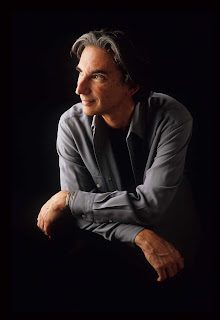O2 Arena
May 18
Obecní dům
May 20
 |
| A refined sound in a distinctly unrefined space. |
Had enough of Mahler yet? At this point in the extended two-year commemoration of the composer’s birth and death, there seems little left to discover. But even for jaded listeners, a pair of Prague Spring concerts this past week offered something special: An opportunity to compare how European and American orchestras approach Mahler’s towering symphonies.
Getting to the first performance, at O2 Arena on Wednesday, required going through a metal detector and airport-style frisking. So it was a pleasant surprise to find a dignified atmosphere inside, with low lighting and enormous black drapes framing a huge stage erected along one side of the floor. It was quickly filled by two orchestras – the Czech Philharmonic and NDR Symphony Orchestra Hamburg – and seven singers on a raised dais. Above them, six German and Czech choirs filled several sections of seats normally packed with hockey fans.
The task of weaving all this into a credible “Symphony of a Thousand” (No. 8) fell to Christoph Eschenbach, whose 60-year career in classical music spans two continents and includes leading posts at half a dozen major orchestras. Visually, it was like watching a pygmy trying to wrestle an elephant into submission. Musically, it was sublime, with Eschenbach crafting a surprisingly nuanced performance with outstanding clarity, balance and sensitivity, particularly in the vocal and choral passages of the second half, as love triumphs and Faust’s soul ascends to heaven.
Given all the time he’s spent in America, Eschenbach might not be the ideal exemplar of the European style. But his treatment certainly had the grandeur and stately pacing of the European Mahler, with a monolithic orchestral sound that left plenty of space and accommodation for the soloists, choral passages that swelled, broke and receded like ocean waves, and an earth-shaking finish. As much as any Beethoven or Wagner work composed decades earlier, it was a grand and eloquent statement of Romantic ideals and spiritual aspirations.
And surprisingly, the venue helped. When the Czech National Symphony Orchestra mounted a production of No. 8 at Obecní dům in January, it sounded constrained, almost preposterously disproportionate not just to the space, but the very idea of a symphony. At the arena, where the music had room to expand and breathe, it was breathtaking in its scope and impact, like an enormous mosaic that comes into focus only at the proper distance. And the real stars of the show may have been the sound engineers, who miked the orchestra and the soloists (though not the choirs) and blended it all so well that individual voices and instruments were exceptionally clear, even on the far side of the arena.
 |
| New World sensibilities. |
Back at Obecní dům two nights later, it was immediately clear that an American orchestra was onstage, with the musicians in their seats tuning up as the audience filled Smetana Hall. An orchestra director in Prague once suggested that his musicians follow that protocol, and they didn’t much like it, preferring to walk onstage to applause after the audience is seated. It’s a minor ego exercise, and perhaps a matter of tradition. But the atmosphere is strikingly different when the musicians are already onstage, charging the air with anticipation.
This was the third Prague Spring appearance for the San Francisco Symphony, and with Michael Tilson Thomas at the podium, the orchestra only seems to get better. From the opening notes of Mahler’s Symphony No. 2, the music throbbed with energy and vitality. Even the softer string and woodwind passages were remarkably robust, losing none of the internal dynamics and vivid colors that characterized the entire piece. Overall the sound was polished and bright, with a much higher gloss than one typically hears in Europe.
The performance never lost its Old World grounding, notable especially in the dances of the second and third movements. But there were some distinctly modern touches, with Tilson Thomas emphasizing deep bass lines and adding occasional reverb effects. He showed himself to be a master technician, capable of taking the sound from a tumultuous explosion down to a bare whisper with fingertip control. Unlike many European conductors who start at full volume, he also showed restraint, building the sound carefully to give the late orchestral outbursts a much smarter and cleaner impact.
One could characterize his orchestra’s sound as unremittingly bright – at least by European standards. But as the Czech Philharmonic Choir Brno joined in for the final movement, there was no question that two world-class ensembles had joined to create a thrilling synthesis, the conclusion of which brought a full house to its feet. In a charming display of international bonhomie, both the choir and the orchestra made a point of applauding each other during the three curtain calls.
This is what Prague Spring does best – bring together world-class talent in a framework that only a prestigious international festival can provide. And both Eschenbach and Tilson Thomas offered reminders that, even amid a glut of anniversary events, there is always more to hear and learn from a master like Mahler.
Michael Tilson Thomas talks about Mahler: http://www.youtube.com/michaeltilsonthomas
Christoph Eschenbach on Mahler: http://www.christoph-eschenbach.com/mahler/index.php?m=10&q=1
No comments:
Post a Comment